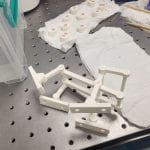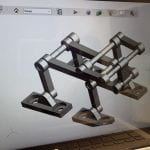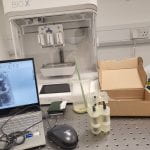STMicroelectronics Internship: Monitoring of heart rate and activities with integrated ECG and motion sensors
By Medical Physics and Biomedical Engineering, on 13 October 2023
Name: Sirine Bhouri
Degree: Biomedical Engineering
Project Title: Monitoring of heart rate and activities with integrated ECG and motion sensors
Supervisors: Dr Terence Leung
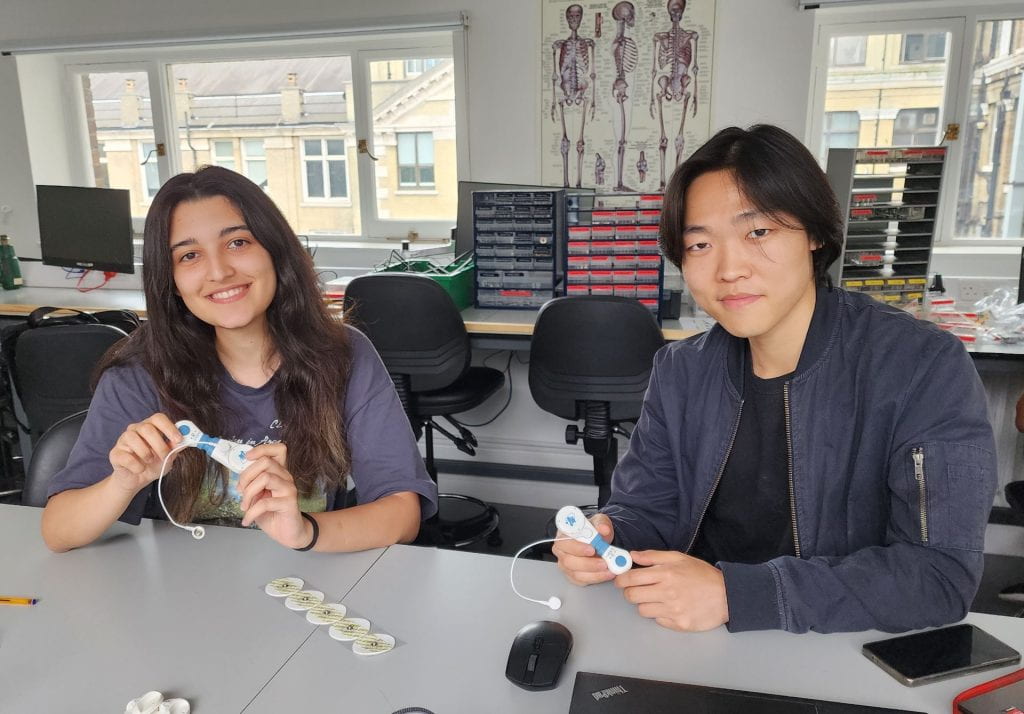
This summer I got the opportunity to work on an 8-week studentship that was organised jointly by UCL and ST Microelectronics Ltd (STM). The aim of the project was to work with STM’s Hi device and investigate a new clinical application for it. By the end of the project, I managed to develop a real-time model of sway as well as a Graphical User Interface (GUI) that uses accelerometer data collected by the Hi device to compute a sway index and output the grade of ataxia of the patient in a timely and accurate manner, thus facilitating the diagnosis and monitoring of ataxic patients.
What immediately appealed to me about the project was the fact that it focused on wearable technology, and programming, whilst providing clinical exposure. I got to interact with patients and clinicians to develop a proof-of-concept that integrated microelectronics into the clinical world, and I learned so much in the process.
Indeed, I got the opportunity to work, share my ideas, discuss my findings with and get feedback from both engineers and clinicians and this was truly an opportunity of a lifetime. It proved to me how important it is to consider both the engineering and clinical aspects if we want to develop an innovative, effective, and useful medical technology.
Realising not only the importance but also the necessity of this interdisciplinarity reassured me that I had made the right decision to study biomedical engineering, which essence itself consists of bridging engineering, physics and maths with biology and medicine to improve patients’ and clinicians’ lives.
In addition to this, working with engineers, clinicians, my supervisor as well as PhD students, taught me to share my findings and present my ideas in a clear and succinct manner. It also improved my ability to receive and implement feedback effectively to improve my work.
All of these learnings and achievements were made possible thanks to teamwork which was key during my studentship. By collaborating continually, I gained insight into various fields and aspects of medical technology development, and I learned so much from each and every single presentation and discussion I had. I also got to meet brilliant people who shared my passion for biomedical engineering and medical technologies, and this made me truly enjoy my time as a student intern!
MPBE Summer Studentship: Building a head and neck atlas for cancer patients treated with radiotherapy using open source data
By Medical Physics and Biomedical Engineering, on 13 October 2023
Name: Rozenn Raffaut
Degree: Medical Physics
Project Title: Building a head and neck atlas for cancer patients treated with radiotherapy using open source data
Supervisors: Dr Jamie McClelland and Poppy Nikou

How did you find out about the studentship? Why did it appeal to you?
I was introduced to the MPBE summer studentship programme while I was completing a placement with the Radiotherapy Image Computing Group (RTIC) last year (2022/23) as part of the Year 2 Medical Physics Research Experience scheme. I was excited to do a summer project with the group, as I had previously learnt about RTIC’s work on radiotherapy, and this was an opportunity to actually contribute to the fascinating research within the Medical Physics department. In addition, I could now apply the Python programming skills that I had learnt during my previous computing modules to a real-life medical physics application.
Can you tell us a bit about the project you are working on?
One of the ways cancer patients can be treated is radiotherapy – in which a dose of radiation is delivered to a tumour in ‘fractions’ over the course of several weeks. Head and neck cancer patients experience anatomical changes over these weeks, such as weight loss or tumour shrinkage, but in order to analyse and compare these changes between patients, they all need to be in the same frame of reference. To prevent bias, this frame is an “average patient” – an atlas. My project consists of creating an atlas from open-source head and neck CT data using groupwise image registration (aligning many images to each other) for future use in radiotherapy research.
How are you finding the experience? How do you think it is benefiting you?
So far, it has been a very fulfilling and rewarding experience: I particularly enjoy getting to know the different tools that are used in research, such as the NiftiReg image registration software and the diverse uses of Python modules in image processing. My project supervisor, Poppy Nikou, as well as RTIC’s PI, Dr Jamie McClelland, are always open to questions and willing to explain how things work. I believe that this project has helped me further develop my Python programming skills and has offered me more insight into the medical physics research environment at UCL.
What does this experience mean for your future career?
The work with RTIC has led me to consider medical physics research as a career path after I will complete my MSci Medical Physics course in two years’ time, as well as providing invaluable experience within a research environment. Furthermore, it has increased my interest for the image processing and analysis aspect of medical physics, which I hope to explore further during my future studies, and potentially as part of my master’s year project.
MPBE Summer Studentship: Characterisation and implementation of optical ultrasound generating membranes
By Medical Physics and Biomedical Engineering, on 13 October 2023
Name: Donny Liu
Degree: Biomedical Engineering
Project Title: Characterisation and implementation of optical ultrasound generating membranes
Supervisors: Dr Erwin Alles and Fraser Watt
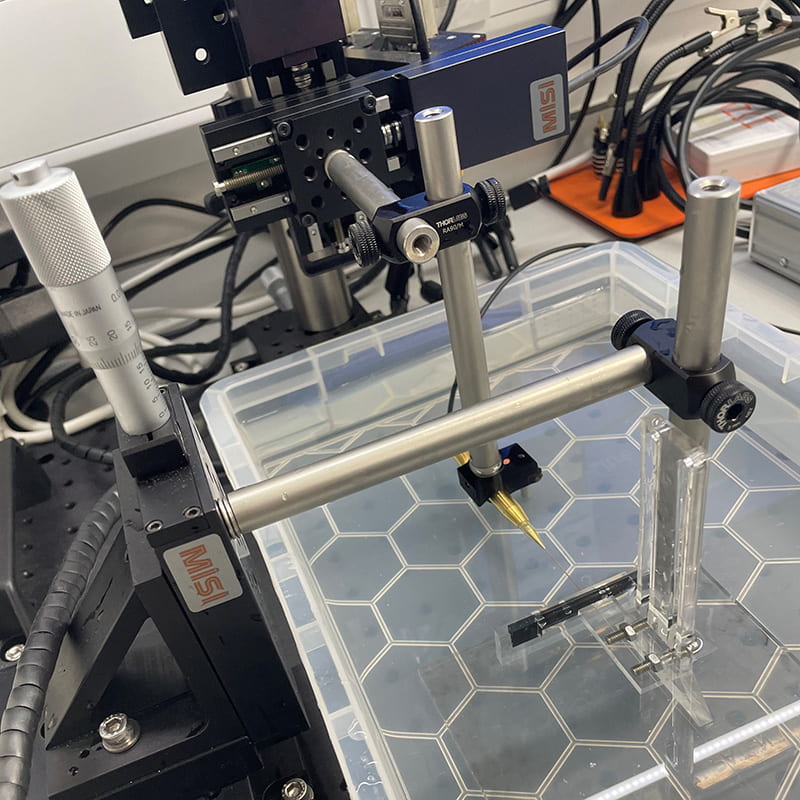
I met my supervisor, Erwin Alles, during the scenario week, and I discussed with him that I was interested in gaining more research experience, he directed me towards the summer studentship. I think what makes the summer studentship programme so attractive is that you get exposed to the day-to-day life of a researcher and get involved with cutting-edge science.
My project focused on ultrasound-generating membrane characterisation. The membranes generate ultrasound through the photoacoustic effect and are used in imaging. The goal of my work was to investigate methods for membrane fabrication and design a process to test the membranes, with the goal of improving membrane performance. This included designing the experimental setup and writing a data analysis code. I have also developed a new membrane fabrication method that could improve the membrane performance.
The first half of my studentship involved a lot of redesigns and adjustments to experimental methods. In the first month, I had four redesigns of my experiment setup, which is an average once per week. I never thought of this as a challenge; on the contrary, I feel it’s interesting to try a new experiment setup and assess how it works. A stable, accurate, and efficient setup in the end is most encouraging.
I really appreciate my supervisors and team members. They left me a lot of lab time and offered a great degree of freedom during these two months. I often shared my findings and results and asked for their advice. When I developed the new fabrication method, and identified that the performance had improved significantly, my supervisors gave many suggestions about what test should be carried out.
This is a fruitful experience for me. I learned many valuable for research and presenting data. This project demonstrated the benefits of research work and has really confirmed for me that it is something that I would like to pursue in the future.
For students in the future, my suggestions are to be curious and never afraid to share your ideas. Remember that you are working with a new science topic and everything you find might be new to the world.
MPBE Summer Studentship: Development of resources for new Scenario
By Medical Physics and Biomedical Engineering, on 11 October 2023
Name: Clement Hiscock
Degree: Biomedical Engineering
Project Title: Development of resources for new Scenario
Supervisors: Eve Hatten

My project focused on developing a system for mouse control using electrooculography (EOG) and testing its validity as an undergraduate scenario. The project really appealed to me as it provided an opportunity to further my research, technical and communication skills.
My role in the project was to try and make a range of EOG mouse systems and collect data on their strengths and weaknesses. I started the project by researching EOG; To very briefly summarise EOG, it works by using electrodes to detect the deflection of the eye. The electrodes detect the deflection of the retina cornea dipole and this is then mapped to deviation of the eyes.
In order to make a functional mouse system we decided that it would need to be able to move the mouse up, down, left, right and to be able to click. With these requirements in mind I created four unique systems.
The first system used a signal conditioning circuit which involved amplification and some noise removal. This first system had the DC component of the signal left in; This meant three channels could provide the five degrees of freedom as one channel could distinguish between opposite movements.
The second system used a signal conditioning circuit which had a high pass filter to remove the DC component of the signal. This provided stability to the signal.
The final two systems I created aimed to overcome the largest problems with the first two. The first system had very clear distinction between opposite movements on the same channel but there were big problems with baseline drift. The second system was very stable but it proved very complicated to garner five degrees of freedom from only three channels as the difference in opposite movements was indistinguishable.
To solve the problem in the first system I introduced a peak detection; This algorithm meant that instead of checking for a voltage threshold it averaged the last few values and then checked for outlier values that signalled eye movement . This meant the code effectively ‘followed’ the signal removing the baseline drift issue
The solution to the issues in the second system was much more simple. I added two further channels so that each movement of the mouse was controlled by a separate channel. This removed the need to distinguish between opposite movements on the same channel.
Eve was a great supervisor; She really gave me the freedom to explore all of the ideas I had without restriction but was also very present when I had issues that I was struggling with. She also provided invaluable insight into the considerations that go into designing projects for students.
I would highly recommend other students to apply for this studentship. It was a great project that developed my research, communication and technical skills. My only advice to other students doing the project would be to keep your approach broad; It is very easy to get locked into your first approach but try and avoid this and keep developing your whole range of ideas!
MPBE Summer Studentship: Compact robotic manipulator for MRI-guided neurosurgery
By Medical Physics and Biomedical Engineering, on 11 October 2023
Name: Lorenzo Aragon
Degree: Biomedical Engineering
Project Title: Compact robotic manipulator for MRI-guided neurosurgery
Supervisors: Dr Ziyan Guo
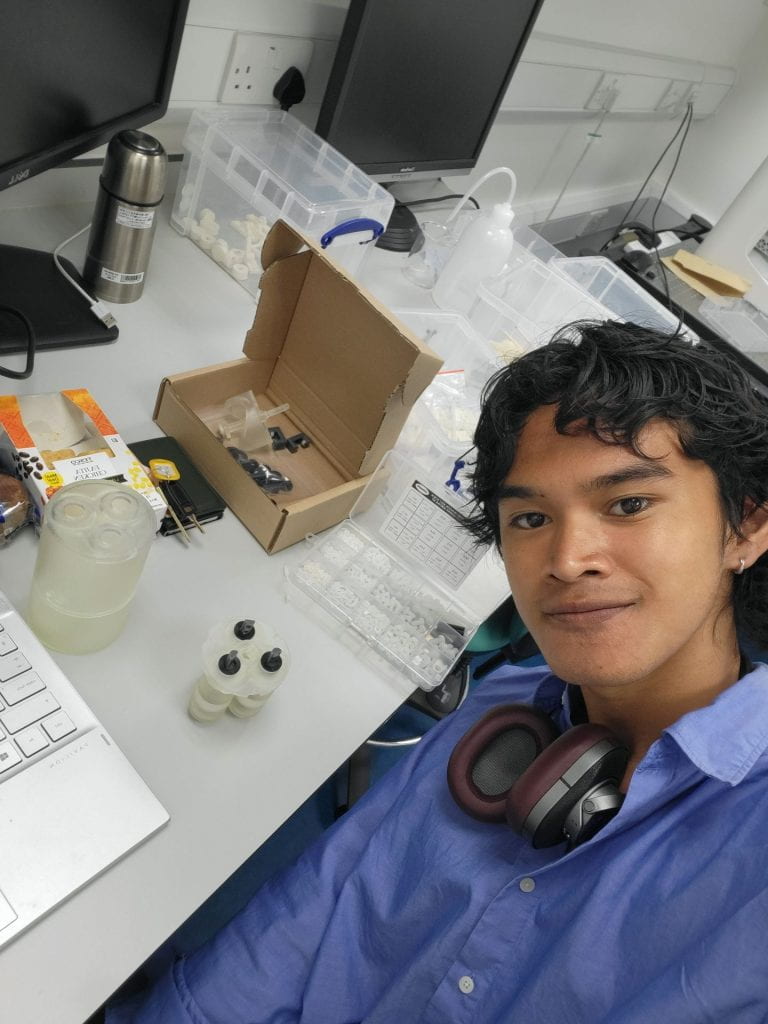
I embarked on an exciting summer internship, joining the Compact Robotic Manipulator for MRI-Guided Neurosurgery project. This report highlights my experiences, role, challenges faced, and key takeaways from this enriching opportunity.
Why This Project Appealed to Me:
The project’s challenge of designing a compact robotic manipulator for MRI head coils, minimizing electromagnetic interference, captivated me. My interest in 3D printing and my supervisor’s expertise in stereotactic neurosurgery further motivated my involvement.
Project Description and My Role:
As an intern, I primarily assisted in tasks, such as literature reviews on MRI robotics and hydraulic motor mechanisms, CAD work using SolidWorks, learning manufacturing techniques like 3D printing and laser cutting, and sourcing components. Additionally, I co-hosted the In2Science placement programme for a week, introducing A-level students to STEM fields.
Challenges Overcome and Enjoyable Aspects:
Having only met in-person towards the end of the 3rd week, I was initially quite intimidated at the thought of contacting my supervisor. However, I came to realise that she was someone to guide, not grade, my progress, which improved our collaboration. The hands-on experience, especially 3D printing and troubleshooting, was very enjoyable.
Relationship with Supervisors and Team:
My relationship with my supervisor Ziyan Guo was very positive; she was extremely kind and fostered an environment of open communication and collaboration.
Benefits and Impact:
This internship offered insights into researchers’ lives, including proposal management and deadlines. It reinforced the practical application of technical knowledge, showing how our academic concepts translate into real-world innovations, like how what we learned in our Medical Imaging module can be used to develop MRI-compatible robotic manipulators.
Advice for Future Students:
To future interns, don’t hesitate to contact your supervisor for any reason. Building a strong relationship early enhances the learning experience.
In conclusion, this summer internship has been a transformative journey. It deepened my passion for robotics and medical applications, providing practical skills and insights that will shape my future endeavours. I’m grateful for this opportunity and look forward to applying these experiences in my academic and professional pursuits.
MPBE Summer Studentship: Incorporating spatiotemporal patterns of brain development into paediatric brain tumour radiotherapy planning to reduce treatment side effects
By Medical Physics and Biomedical Engineering, on 11 October 2023
Name: Saarah Hussain
Degree: Medical Physics
Project Title: Incorporating spatiotemporal patterns of brain development into paediatric brain tumour radiotherapy planning to reduce treatment side effects
Supervisors: Dr Jamie Dean and Mohammad Amin Lessan
 As my 10-week summer placement with UCL Medical Physics & Biomedical Engineering officially comes to an end, I am incredibly thankful to have had the opportunity to contribute towards research in paediatric brain tumour radiotherapy alongside an amazing team of students and professionals alike.
As my 10-week summer placement with UCL Medical Physics & Biomedical Engineering officially comes to an end, I am incredibly thankful to have had the opportunity to contribute towards research in paediatric brain tumour radiotherapy alongside an amazing team of students and professionals alike.
The interdisciplinary nature of this project is perhaps what caught my attention to begin with; combining my interests in software engineering, coding, and physics, while also delving into the intricate world of healthcare. This multi-faceted project presented a stimulating and challenging opportunity which aligned perfectly with my career aspirations, offering an opportunity to truly make a meaningful impact.
The spatiotemporal variation in radiosensitivity is not accounted for in current treatment approaches – which may go some way in explaining why debilitating neurocognitive side effects due to radiation-induced brain damage occur all-too-often. At the very crux of this project lies the desire to exploit this spatiotemporal variation in order to design novel personalised planning approaches which can avoid the most radiosensitive regions of the brain.
My role thus involved engaging in a diverse range of data analysis tasks encompassing both human brain data and mouse brain data. During the early stages of my placement, I conducted a comparative study on the apoptotic sensitivity of various genes by analysing gene expression data obtained through RNA sequencing. Creating visual representations depicting this data across distinct brain regions and at different life stages offered valuable insights into the spatiotemporal variations in radiosensitivity within both human and mouse datasets. Particularly noteworthy were the similar patterns observed in both datasets; these findings highlight the comparability between the human brain and the mouse brain and, most importantly, their analogous responses to radiotherapy.
The latter part of my placement primarily involved investigating the mouse brain radiotherapy response with a view to comparing this with human radiotherapy predictions. This was made possible using a dataset with multi-modal imaging of proton-irradiated mouse brains – containing CBCT and MRI scans, a mouse brain atlas, and whole-brain tissue sections with histochemical and immunofluorescent markers for morphology. By using the DAPI-stained histology images to count the number of nuclei across different brain regions, we can compare nuclei count between irradiated and unirradiated areas and thus provide valuable insight into cell loss due to radiotherapy.
It has certainly been a challenging 10 weeks – yet it was this very challenge which ensured that every single day was as stimulating as the day before. Working closely with everyone in the lab has been the greatest pleasure and I have been incredibly fortunate to join such a friendly and welcoming team. My supervisors in particular have been amazing and I am incredibly grateful for their support, time, and guidance over the past 10 weeks as they helped me to navigate an entirely new domain and build an entirely new skillset.
To have really been immersed in the world of healthcare research has been such an enjoyable and rewarding journey. At its core, research is collaborative. I think that has been one of my key takeaways from the past 10 weeks – and contributing in discussions with researchers from leading universities all over the world has definitely shown me just how true that is. From the familiar world of Python, to the very unfamiliar world of QuPath, Napari, Cellpose, Fiji, and beyond… this placement has certainly been – above all – a learning experience.
I am eagerly looking forward to continuing on this journey and applying the valuable skills I’ve acquired during this placement throughout my degree and beyond – perhaps even as part of my own PhD one day. A massive thank you to UCL Medical Physics & Biomedical Engineering for giving me the opportunity to delve deeper into the world of Medical Physics and to contribute towards research that truly makes a difference.
MPBE Summer Studentship: Teaching resources for 3D printing of clinical training models
By Medical Physics and Biomedical Engineering, on 10 October 2023
Name: Karol Duque
Degree: Biomedical Engineering
Project Title: Teaching resources for 3D printing of clinical training models
Supervisors: Prof Adrien Desjardins and Jia-en Chen

When applying for an internship with the MPBE department this summer I had a general idea of the skills I wanted to put at work and further develop. Among those skills was CAD design and 3D printing which put the project with Adrien Desjardins and Jia-En (Danny) Chen on the list of my top three choices. What was even more appealing about this project were the close connections between the research team and doctors at the National Hospital for Neurosurgery and Neurology. This opportunity meant to me that I would be able to learn from two different perspectives, the engineer’s point of view and the doctor’s point of view. The possibility to design, fabricate and evaluate phantoms for neurosurgery and cardiac surgery fascinated me and I was ecstatic when I received the email confirming that I had been selected for the internship.
From the job description alone, I was not entirely aware of everything I would be doing. On the first day, Danny had already taken me to see almost all the 3D printers that would be available to me within the UCL vicinity. This included visiting the labs at Charles Bell House, Zayed Center, Bartlett, GOSH, NHNN and later on the School of Pharmacy. The first week I began to feel overwhelmed by the amount of information I was processing because I was learning how to use Mimics and 3-matic to process and edit MRI and CT scans, as well as doing research on different 3D printed skull phantoms and the materials used to simulate the different parts of the skull and brain. Fortunately, I soon found out my supervisors were keen to help me during this learning process and available whenever I had any questions. My supervisor provided me with all the information I needed to learn how to use the CAD softwares, and on multiple occasions guided me through the processing of images for 3D printing.
Throughout the internship, we worked mainly on pituitary tumor phantoms. This involved 3D printing molds of the tumor and using different silicones such as Ecoflex and Dragon Skin, or gel wax to mimic the mechanical properties of a pituitary tumor. The phantom would later be combined with the 3D printed skull phantoms for neurosurgeons to test during drilling and tumor removal training courses at NHNN. However, along the way my supervisor met with doctors who took an interest in his research and more projects became available. We began working on a new skull base and spine phantom which required a brain model, and a spine and hip bone phantom for csf extraction training. With more projects becoming available, I understood that having a solid base of CAD and basic anatomy knowledge can takeyou a long way. I am grateful for having had the opportunity and given the time to learn these skills and reinforce them throughout my 8 weeks at CBH.
This has been an insightful and enriching experience where I have been able to not only learn what research is about but also understand how important it is to collaborate with people in various fields. My supervisor brought me along to meet with people working in different fields such as AI and VR, medical imaging, and material analysis, and it is the collective experiences and knowledge of everyone that has helped him to progress his research. I have received so much support from both my supervisors and other individuals I worked with throughout the internship and felt that my input was valued. To future students taking on a studentship I recommend asking as much as possible and getting involved in everything you can because this is the best way to discover what career path to take.
MPBE Summer Studentship: Multispectral imaging of skin reaction in radiotherapy
By Medical Physics and Biomedical Engineering, on 10 October 2023
Student: Charlotte Wei
Degree: MEng Biomedical Engineering
Project Title: Multispectral imaging of skin reaction in radiotherapy
Supervisor: Professor Adam Gibson
Project and My Role
I chose to participate in the project titled ‘Multispectral Imaging of Skin Reaction in Radiotherapy‘ due to my profound interest in the medical and physiological aspects of biomedical engineering. Additionally, this project perfectly aligned with my enthusiasm for medical imaging. The project aimed to explore the potential of multispectral imaging in predicting and monitoring local adverse skin reactions following radiotherapy. In this endeavour, my role primarily entailed building upon the foundations of a successful undergraduate project, conducting extensive literature reviews, and optimizing experimental methods. My goal was to enhance the existing experiment to yield superior results while exploring various image processing and analysis techniques.
Independent Work and Supervisor Support
While I mainly worked independently, I enjoyed the consistent support and invaluable guidance of my supervisor. Our weekly one-on-one meetings provided a platform to discuss research progress, study outcomes, encountered challenges, and the strategic steps forward. Moreover, all the lab work was guided by the supervisor. The eight-week duration of this project allowed me to fully immerse myself in its intricacies. Furthermore, it provided me with the opportunity to develop experimental methods based on comprehensive literature reviews and engage in hands-on laboratory work. This aspect of the project was profoundly fulfilling.
Benefits and Key Learnings
This experience has been exceptionally beneficial to my academic growth. Despite having previously completed an A* EPQ project, my prior endeavours primarily revolved around literature reviews with limited exposure to hands-on experimentation and raw data analysis. Engaging in this project offered me invaluable insights into the workings of undergraduate projects and the approach to academic research within a university context. It has significantly bolstered my confidence and readiness for my upcoming third-year undergraduate project.
During the project, my understanding of what constitutes a successful research project evolved significantly. Initially, my focus was on quickly obtaining definitive results. I now understand that the true essence of success in academic projects lies in more than just conclusions. Completing a project, I learned, is a complex and lengthy undertaking that can span years, involving meticulous and often unexpected twists. It is normal to not find an answer, but each endeavour contributes to the larger body of knowledge. Even proposing novel research directions or methodologies that give clearer results can be regarded as a significant achievement. This change in perspective has proven to be an invaluable lesson, one that will undoubtedly shape my approach to future academic and professional pursuits.
How to decorate your halls room
By Medical Physics and Biomedical Engineering, on 21 September 2023

Moving into halls can be nerve-wracking in terms of packing, especially if you come from outside the UK as you can’t bring everything you might want to decorate your new room with you.
As a 4th year UCL student, here are my tips on how to decorate your hall room:
- Take a step back and consider the layout. Most rooms come with a standardised layout, which isn’t necessarily the most efficient disposition. See if you could move the bed or the desk to make more space available. This newly emptied space shouldn’t necessarily be filled with stuff since that room is going to be where you spend most of your time; you need to leave yourself space to live.
- Be wary of attaching things to the walls. Most accommodation halls require a safety deposit, from which deductions will be made if there is any considerable damage to the room. Often, this includes paint chips on the wall due to blue tac, command hooks, adhesives, etc. To be able to have posters and pictures up on your room walls, I would recommend laying some painter’s tape before putting any adhesive on the wall, so later you can remove it and it will not leave much of a trace.
- It is also important to have good lighting. One of the biggest shocks for me during the first year was the fact that during winter the sun sets very early (around 4pm). So, it was very important for me to have good lighting in my room since natural light wasn’t an option. I recommend buying an additional bedside lamp with a warm-toned light bulb, especially if the ceiling light feels too white or abrasive.
- Finally, I would recommend not going too crazy on the decorations, since you will most likely be moving out in 9 months. Your room should be cosy and welcoming without it being too crowded.
Welcome, 1st year students, good luck moving and happy decoration!
This blog was written by Ines, MEng Biomedical Engineering
Tips for getting along with your new housemates
By Medical Physics and Biomedical Engineering, on 19 September 2023

The main thing that I was worried about before starting university was what would it be like living with a group of people I’d never met before! It can seem very daunting, as realistically it might be the one and only time in your life you have to move in with people you’ve never met before that day, but it’s important to remember everyone is feeling the exact same! The majority of UCL accommodations have smaller flats than at other universities outside of London. This gives it a much more family feeling, which is really nice, and also it means you know everyone pretty well within the first week. I shared a flat at Schafer House with 4 others, and here are some tips based on my experience I would share to make that transition as smooth as possible:
- I would highly recommend bringing a door stop or similar to prop your door open for the first day or two, as it’s much easier to break the ice when you first move in rather than days later when you inevitably awkwardly run into each other in the kitchen in pyjamas! Make the effort to start a conversation and find out lots about your flatmates, after all, you will be seeing a lot of them, and also try and do something together to make this feel more natural, even if it’s as simple as a trip to the supermarket to get that first food shop. I first met my flatmate Dion the morning after I moved in, and within 5 minutes we were heading to Lidl, only really learning the basics about each other en route! Almost a year on, we are best friends at uni, living together next year and have also visited each other’s houses this summer. Obviously, you don’t have to be best friends with everyone but be open to getting to know your flatmates, even if they have very different interests to you, as it’s just nice to come home after lectures to unwind with people you can have a great conversation with over dinner.
- Another thing I would recommend is to bring something to share when you move in! I brought a box of celebrations to leave on the kitchen table with a note, and food is always a good way to win people over. My flatmate Jack then one-upped me with a large crate of beer, so this can have other advantages when everyone wants to make a great first impression!
- It’s natural to want to come across as very easygoing during freshers, but whatever you do, don’t do people’s washing up for them and don’t offer all your food to everyone either! Hold people responsible for keeping the flat tidy from the beginning, and then hopefully it should stay that way. Be firm but also understand that you are all learning how to look after yourselves together, and some people may need some extra help.
- Plan some nice things to do as a flat during the daytime, as well as just nights out. Over the course of the year no doubt you will go to lots of club nights or trips to the student bars with your flat, but it’s important to still socialise and have nice things to do together during the days when you have fewer lectures, on weekends or after exam seasons. As a flat we went ice skating, swimming in Hampstead Heath ponds and even went on a trip to Venice! We also watched lots of tv together: football matches, UCL competing on University Challenge and The Apprentice (a firm favourite!). This all helps university feel more homely, and can be combined with a trip to get lots of snacks!
- Finally, check up on your flatmates as without your family there it’s important you all look after each other, and in many ways, they are your family for the year and everyone needs someone looking out for them, especially in what will be a very busy year!
This blog was written by Emily, Medical Physics
 Close
Close




